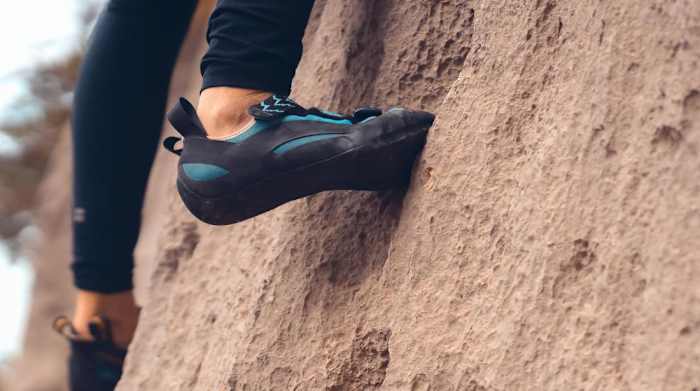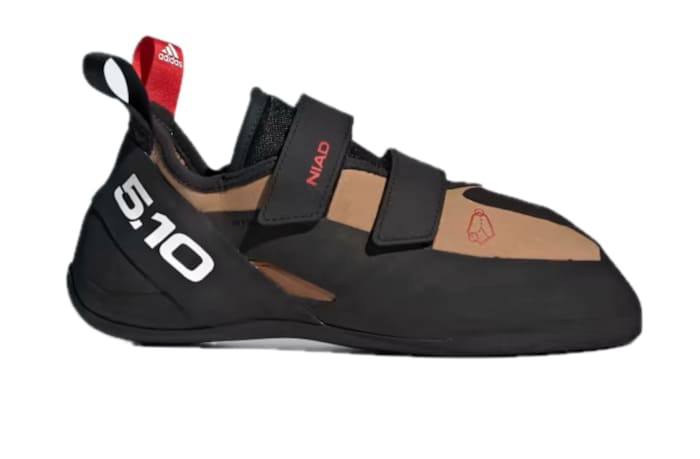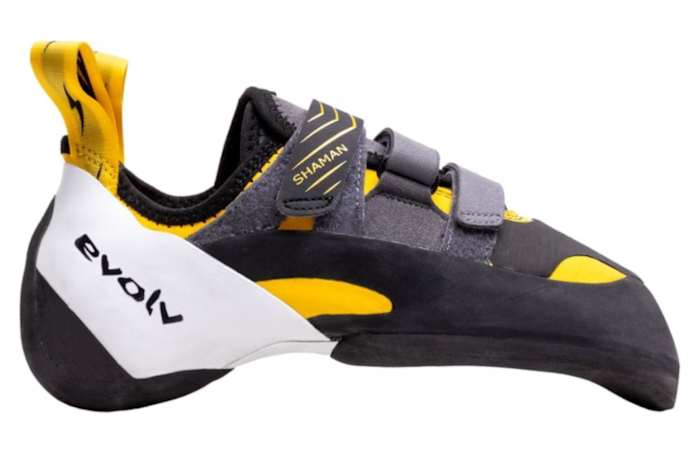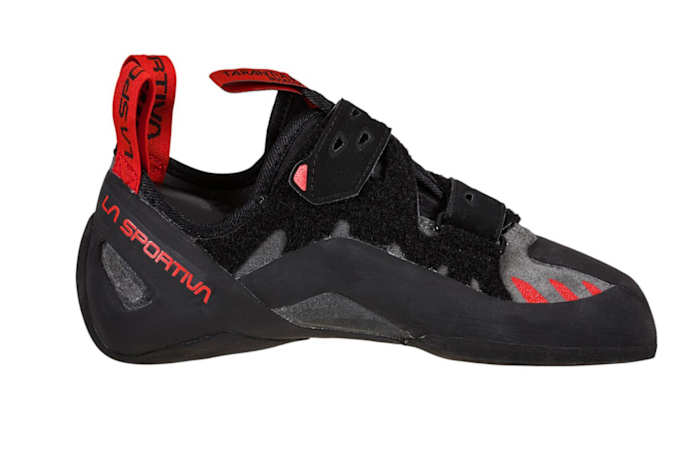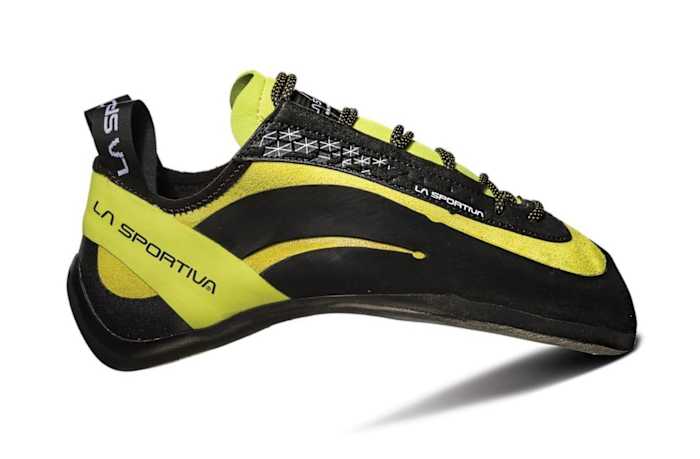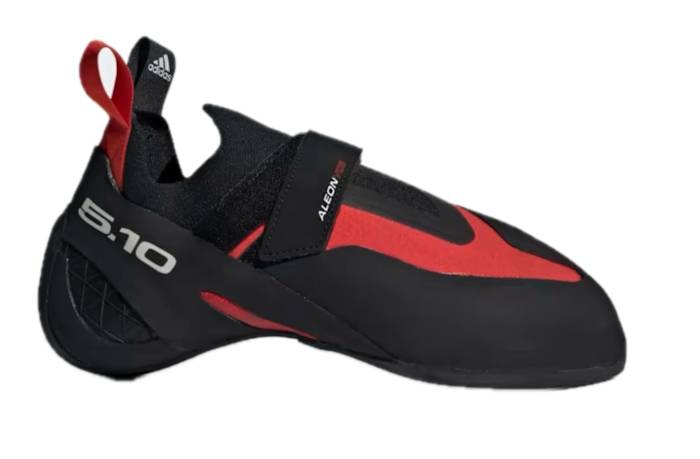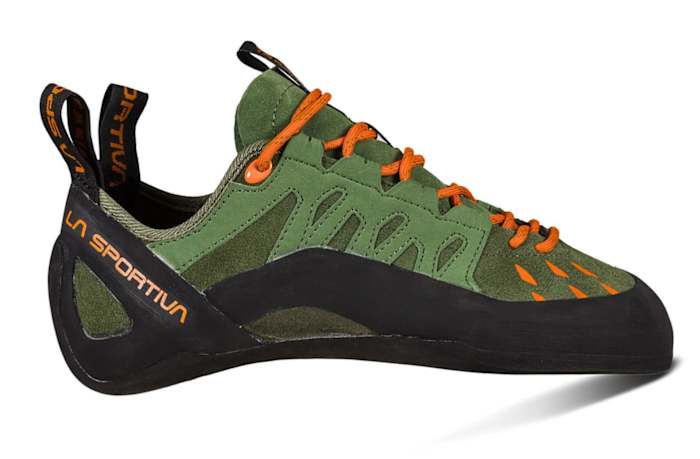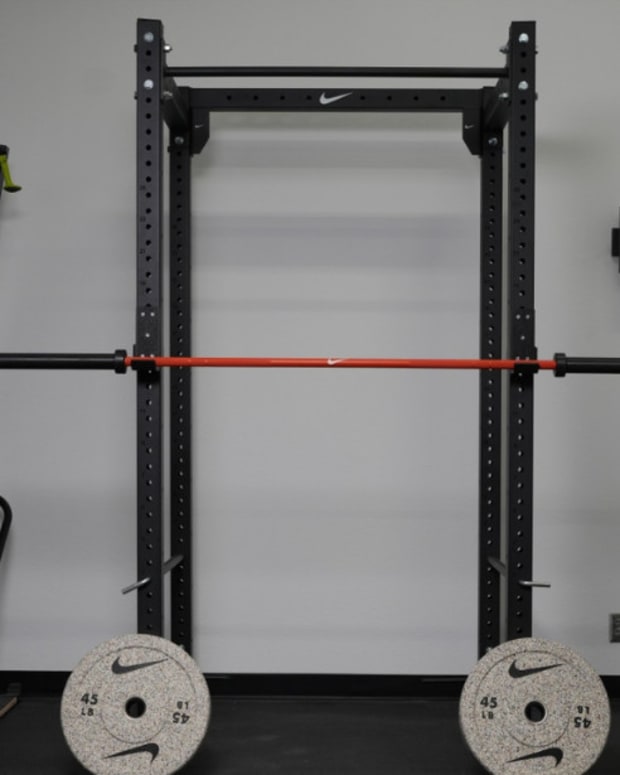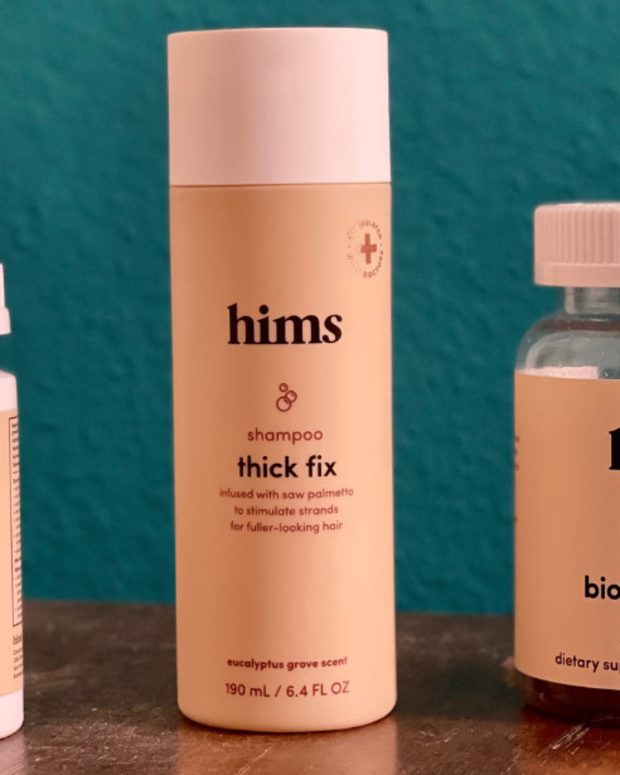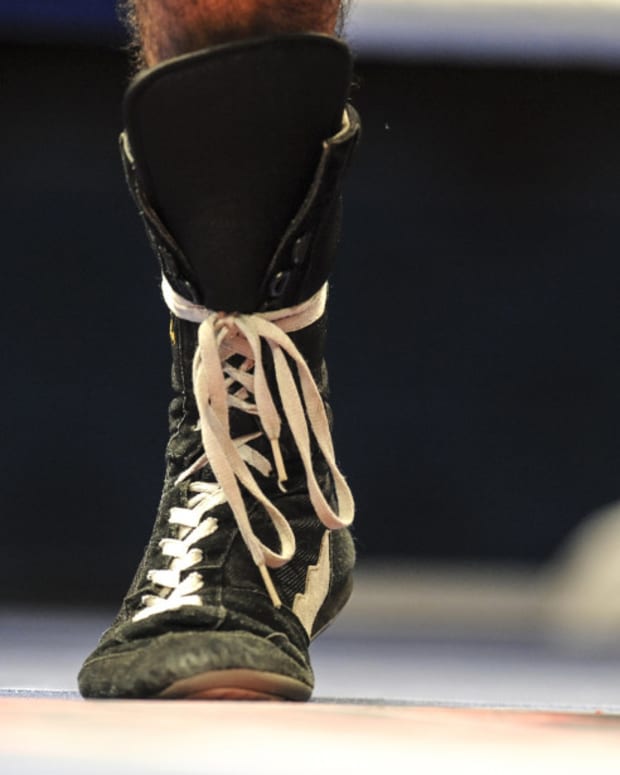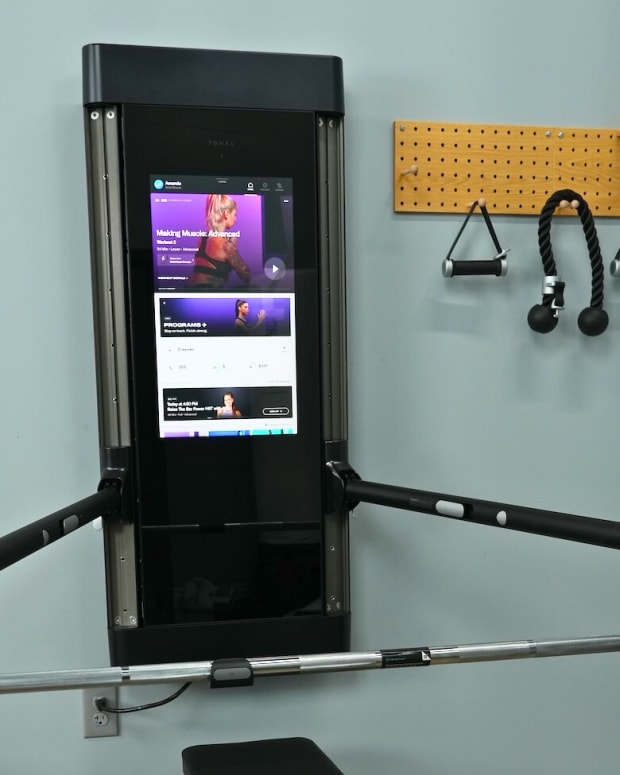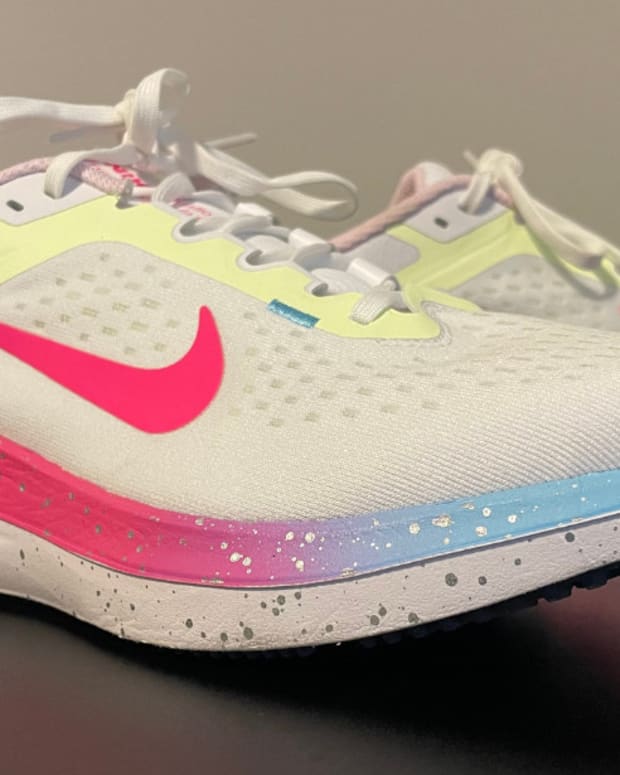The products featured in this article have been independently reviewed. When you buy something through the retail links on this page, we may earn commission at no cost to you, the reader. Sports Illustrated editorial staff are not involved in the creation of this content. Learn more here.
Climbers will generally have an arsenal of climbing gear, including harnesses and hiking backpacks, but the right pair of shoes will make or break any climb. Whether you’re a beginner climber or a seasoned pro, high-performance climbing shoes can help you maintain grip and/or friction as you scale your favorite rock or cliff. Plus, while it may come as a surprise, comfort isn’t the most important factor when it comes to picking out the right footwear for your climbs.
With the help of climbing experts, our best climbing shoes roundup will dive into every feature you should consider when shopping for climbing shoes (including several that might not come to mind right away). We’ll also share which type of footwear is best for various types of climbing, how to pick a shoe based on your foot shape and how to care for and clean your shoes.
Regardless of your budget, experience level or shoe size, our best climbing shoe guide has options for all climbers and styles. Keep reading for our favorite climbing footwear of 2024, what makes them rank supreme and how to narrow down your choices for the perfect fit (and shoe).
Our Picks for the Best Climbing Shoes:
- Best Beginner Climbing Shoes: adidas Five Ten NIAD VCS Climbing Shoes
- Best Rock Climbing Shoes: Evolv Shaman Climbing Shoes
- Best Climbing Shoes for Bouldering: La Sportiva Tarantula Boulder
- Best Indoor Climbing Shoes: Scarpa Instinct VSR
- Best Climbing Shoes for Wide Feet: adidas Five Ten NIAD Lace Climbing Shoes
- Best Gym Climbing Shoes: La Sportiva Miura
- Best Sport Climbing Shoes: adidas Five Ten Aleon Climbing Shoes
- Best Budget Climbing Shoes: La Sportiva Tarantulace
Best Beginner Climbing Shoes: adidas Five Ten NIAD VCS Climbing Shoes
Key Features:
- Designed for indoor gym and outdoor use
- Hook-and-loop closure
- Microfiber upper with minimal stretch
- Tension transfer from heel to forefoot
Our best all around climbing shoes for beginners are the adidas Five Ten NIAD VCS Climbing Shoes, which rank number one on our list for several reasons. Not only do these shoes (which retail at $150) have a sleek appearance, they’re designed for climbing and pushing limits. With the brand’s trademark Stealth rubber outsole and toe coverage, which offers enhanced durability and grip, these shoes work equally well climbing at a gym or at your favorite outdoor terrain.
The shoes tend to have a tight fit, so you may want to consider sizing up if you have wider feet or prefer a more roomy feel, but the snug design is intentional to help you maintain your footing as you scale steep terrain or edge along small footholds. The adidas Five Ten NIAD VCS are also unlined, so you can expect these shoes to have a bit of give, though you may need to break them in with a few climbs to reach maximum comfort level. The synthetic upper, on the other hand, is one part of the shoe that won’t stretch out, as leather uppers tend to stretch more.
Other features you’ll find on these entry-level climbing shoes are a convenient hook-and-loop closure system, medium-stiff midsole to support your feet and extended rubber on the toe box area that offers both extra grip and additional protection for your toes. Still, don’t overlook this beginner shoe if you’re a more seasoned climber—adidas Five Ten NIAD VCS work just as well for climbing experts, and can be used for a variety of styles of climbing that range from easy to tough. Plus, with their tan, black and white color scheme, you’ll perfectly match the outdoors.
Ranging in size from 3.5 to 15, customers of almost all shoe sizes will be able to consider these shoes. Overall, buyers say the rubber on the shoes is “stiff enough to stand on small [foot] chips, but still sticky enough for volumes and smearing.” They also note great tension transfer from the heel to the forefoot. “They even performed well on overhang,” one buyer adds of rock faces or climbing falls with a slope of more than 90 degrees. While a few customers complain about a tight fit and needing to size up, they give these shoes an average rating of 4.4 out of 5 stars for quality.
Pros:
- Wide range of sizes (3.5 to 15)
- Unlined design is easy to break in
- Additional rubber on toe for extra protection
- Snug fit supports edging and sensitive smearing
Cons:
- Only comes in one color scheme
- Some customers say shoes run small
- May require some breaking in
Best Rock Climbing Shoes: Evolv Shaman Climbing Shoes
Key Features:
- Downturned toe profile
- Split soles for independent front and back foot movement
- Three-strap closure for extra compression and security
- Extra space above toe knuckles for comfortable curling
Those seeking out aggressive climbing shoes for rock climbing should look no further than the high-end Evolv Shaman Climbing Shoes, which come in sizes 7 through 13 for men and 5 through 13.5 for women in a low volume variation. Costing $199, these shoes are designed in a downturned shape (meaning the toe part of the shoe is pointing down) with a molded plastic concave midsole that helps reduce unnecessary space under the toes, creating a seamless fit.
Above the toe knuckles, meanwhile, is special knuckle box technology that offers additional space for the toe knuckles to curl, generating all-day comfort and flexibility for longer climbs. Also adding to Evolv Shaman’s versatility is two-part split soles with a tensioned rubber arch that allows for separate movements of the front and back foot for maximum manueverability. There are split tongues as well in this comfortable shoe that make it easy to take on and off.
However, it’s not just comfort that makes these shoes excellent for rock climbing (and as we mentioned earlier, comfort, while important, doesn’t have the same weight in climbing shoes as it does in street shoes). Evolv Shaman comes with a three-strap closure system that further boosts compression and security. These velcro straps keep the forefoot and arch stable while simultaneously locking in the heel portion of the shoe. In addition, they’re made with a synthetic upper and lining, leading to stiffer shoes that won’t stretch out or become loose over time.
While the men’s shoe is technically unisex, you may want to purchase the women’s variation for a more precise fit (but keep in mind the women’s shoes are low volume, which are narrower and have a smaller heel). A few customers note that breaking these shoes in can be challenging, but most have overwhelmingly positive things to say about their climbing experience. “My feet don’t slip inside the shoe,” one buyer says, “whether it’s on sharp overhanging boulders, thin slab or day-long, multi-pitch climbs.” Others love the smaller heel cup that they say creates a perfect fit.
Pros:
- Great for overhang climbs and edging
- High knuckle box gives extra room for toes
- Two-part split soles generate more responsiveness
- Velcro closures make it easy to put shoes on
Cons:
- Higher price point
- May not be beginner-friendly
- Shoes may be too stiff for some climbers
Best Climbing Shoes for Bouldering: La Sportiva Tarantula Boulder
Key Features:
- Increased rubber coverage on heel part of shoe
- Rubber toe cap helps support toe hooking
- Extra sticky toe rand to boost friction
- Can be resoled at a La Sportiva-approved cobbler
If you’re a fan of bouldering, or free climbing on small rock formations or artificial rock walls without ropes or harnesses, a pair of climbing shoes that supports these climbs is essential. Enter La Sportiva Tarantula Boulder, a mid-priced pair of climbing shoes (costing $109) made specifically for this type of climbing. With a downturned toe profile, these neutral climbing shoes have a flexible leather upper and two-millimeter toe rand with FriXion RS rubber, which offers extra stickiness to generate friction and help your toes stick to narrow portions of your climb.
La Sportiva Tarantula Boulder are also made with a more protective toe patch compared to other La Sportiva shoes, which not only offers additional toe protection, but helps enhance the dynamic movements that bouldering requires. A half-sole construction also generates versatile maneuverability and helps reduce waste when resoling your shoes. Speaking of resoling, you can also visit any La Sportiva-approved cobbler to have your shoes professionally resoled.
On top of the features above, these bouldering shoes have extra rubber coverage on the heel construction to boost heel hooks performance, plus rubber toe caps for improved toe hooking. In addition, you’ll find a convenient dual hook-and-loop closure system that is simple to adjust and makes these shoes easy to get on or off (two heel tabs also make wearing them much easier).
Climbers who are environmentally-conscious may also love that La Sportiva is a Climate Neutral Certified brand that prioritizes sustainability. Most buyers say that these shoes run large, and La Sportiva recommends sizing down (while factoring in that these shoes will stretch up to a full size larger). They’re “definitely quality material,” one buyer says. “Bouldering has been nothing but a dream,” another notes. “These shoes have great grip. I would definitely recommend these to anyone who plans on doing lots of bouldering, and wants a good, inexpensive shoe.”
Pros:
- More budget-friendly than other pairs
- Adjustable dual hook-and-loop closure system
- Two heel pull tabs for easy take on and take off
- Extra protective toe patch
Cons:
- May require sizing down a half size or more
- Not aggressive enough for some climbers
- Leather upper will likely stretch with time
Best Indoor Climbing Shoes: Scarpa Instinct VSR
Key Features:
- Aggressive downturned toe
- Microsuede upper with elastic binding
- Two-part sole for dual maneuverability
- Unlined with hook-and-loop strap closures
Indoor climbers who climb on overhung walls with plastic holds, or artificial walls in general, may want to keep Scarpa Instinct VSR climbing shoes at the top of their list of shoes to consider. While these shoes have a high price point of $208.95, their meticulous design may be worth it. For starters, Scarpa Instinct VSR has an aggressive downturned toe that supports edging, technical boulders and narrow spaces in general. It also has a softer midsole for extra flexibility, plus a two-part sole that lets you move the front and back parts of your feet independently.
With an unlined design, you can expect these climbing shoes to have more give than their lined counterparts. Scarpa Instinct VSR also has a microsuede upper with elastic binding, allowing the shoes to conform to the top of your feet and keep them snug during your climbs. Its Vibram XS Grip 2 sole also generates plenty of traction for technical edging and navigating slabs. In addition, a hook-and-loop strap closure system also keeps these puppies tight on your feet.
Customers name these shoes their “favorite shoe for all-around performance.” The “rubber is thick enough to provide support on small feet and is really sticky,” says one buyer who is on his sixth pair of Instincts. “The soft rubber on the VSRs sticks like glue and the sensitivity is unreal,” another customer echoes. While buyers say the shoes don’t stretch much, they offer plenty of power in the toe area and a sturdy heel excellent for heel hooks. For a shoe even better for edging, customers recommend checking out the Scarpa Instinct VS as a strong alternative.
Pros:
- Extremely sticky and sensitive
- Fits both wider and narrow feet
- Snug heel for maximum stability
- Aggressive downturning is great for edging
Cons:
- High price point
- May be too aggressive for some climbers
- Doesn’t break in well
Best Climbing Shoes for Wide Feet: adidas Five Ten NIAD Lace Climbing Shoes
Key Features:
- Lace-up closure system
- High-friction rubber grip
- Extended toe rubber
- Lined microfiber upper
It’s no secret that many climbing shoes tend to run small or have snug fits, but the $150 adidas Five Ten NIAD Lace Climbing Shoes make adjusting shoes for wide feet a breeze. If you’re not a fan of velcro, a lace-up closure system allows you to tighten or widen these shoes to a larger degree. Featuring the same Stealth C4 rubber outsole as the adidas Five Ten NIAD VCS, you can expect these shoes to offer significant friction for edging and smearing. An extended toe rubber also helps add to that friction and make these shoes extra sticky.
All in all, despite the lace closures, these shoes can still offer a snug fit (even for climbers with wide feet). A form-fitting heel helps keep your heel secure during climbs, while a stiff midsole adds balance and stability. With a lined microfiber upper, you can also count on these climbing shoes to keep their shape and stretch much less than their leather upper counterparts. You also won’t have to break them in much, as leather uppers require several climbs to fully stretch out.
With a wide size range of 3.5 to 15 in men’s, climbers of almost all shoe sizes can keep adidas Five Ten NIAD Lace Climbing Shoes on their roster. Many customers with wide feet praise these shoes for their great fit, but those with in-between sizes (like 8.5) struggle to achieve a snug fit, noting excess material above the toe base when sizing up to the larger size. Others report holes after a few months of use, though overall, the general consensus is that these shoes are good quality. If you plan to climb on hikes, be sure to also invest in hiking boots or hiking sandals.
Pros:
- Doesn’t require much breaking in
- Lace closure offers more adjustment
- Grippy outsole for indoor or outdoor use
- Wide size range (3.5 to 15)
Cons:
- May require sizing down or sizing up
- Some buyers report holes after short use
- Not aggressive enough for some climbers
Best Gym Climbing Shoes: La Sportiva Miura
Key Features:
- Aggressive downturned toe profile
- Slingshot rand for versatile movements
- Leather upper
- One-pull lace-up closure system
If you’re a fan of climbing but don’t have climbing terrain near you, climbing at a gym is a great alternative (and an environment that many new and experienced climbers prefer). Whether you’re bouldering, top rope climbing or lead climbing at a climbing gym, La Sportiva Miura are a must to consider for your climbing arsenal. As our favorite gym climbing shoes, this $189 pair excels at precision footwork. For starters, they’re made with a high-tension slingshot rand that’s tied into a powerhinge on the sole. When navigating small edges, the weight of your foot will actually stretch the back half of the shoe and not the front, allowing you to carefully climb.
As a stiff pair of shoes, La Sportiva Miura generate maximum support and stability. Like other La Sportiva shoes, they can also be resoled at any La Sportiva approved cobbler, which can be convenient for climbers who want to get the most out of their shoes and don’t know how to resole on their own. Plus, this particular model is one of the most versatile out of the La Sportiva line, thanks to a speed lacing system that allows you to tighten your shoes with just one pull.
Featuring a sleek black and lime color scheme, these shoes are truly a showstopper. Many customers are die-hard Miura fans and stand by these shoes through their various iterations. “It has turned into the shoe I use the most for difficult multi-pitch routes,” one customer says. “It will instantly get you climbing harder routes because it really improves your performance,” another buyer echoes. A few report an easy-to-scratch rubber toe area and changes in sizing from the latest Miura versus previous models, but still gravitate back to the line time and time again. “I’ve tried others in-between, but always come back to Miuras,” says a customer who is on his third pair.
Pros:
- Designed for precision footwork
- Time-saving lace-up system
- Shoe can stretch in the back
- Ideal terrain includes gym climbing
Cons:
- May not be sensitive enough for certain climbs
- Some buyers report inconsistent sizing from previous models
- Customers say rubber on toe area tends to scratch easily
Best Sport Climbing Shoes: adidas Five Ten Aleon Climbing Shoes
Key Features:
- Designed for bouldering and sport routes
- Medium-level stiffness
- Moderate downturned toe profile
- Sock-like construction
When it comes to sport climbing, one of the best climbing shoes on the market this year is adidas Five Ten Aleon Climbing Shoes. Ideal for free climbing supported by permanently-fixed bolts and anchors drilled into the rock, these shoes, which retail for $190 and come in a red, black and gray color scheme, have a convenient slip-on design made snug by a hook-and-loop velcro closure. On the stiffness scale, they fall somewhere in the medium range, but remain flexible to your natural movements with a sock-like construction that hugs the foot.
With a concave toe box, or a semicircular “bowl” shape, climbers wearing these shoes will be able to activate their toes for their climbs, allowing for more precise movements. adidas’ classic Stealth C4 rubber outsole also keeps these shoes extra grippy for those particularly sleek or steep surfaces. In addition, adidas Five Ten Aleon are designed with an ergonomic heel wrap that not only improves comfort, but helps reduce dead space to keep these shoes nice and tight.
Still, you’ll get some flexibility with the Primeknit textile upper, which thanks to its breathable design will also promote ventilation into your feet and help keep you cool. Overall, customers give these shoes a 4.1 out of 5-star rating, with most of the negative reviews noting the need to size up by one or two sizes. On the positive end, buyers praise the adidas Five Ten Aleons for their sticky grip, tension, comfort and solid heel, also noting they’re great for beginners.
Pros:
- Convenient slip-on design
- Reduced dead space in heel
- Rubber outsole offers maximum grip
- Sock-like fit helps with tough holds
Cons:
- Buyers report shoes are very tight
- May be too flexible for some climbers
- Many sizes are out of stock
Best Budget Climbing Shoes: La Sportiva Tarantulace
Key Features:
- Unlined leather upper
- Aggressive rubber heel rand
- Quick-pull lacing harness
- Lined tongue for moisture management
It’s no secret that climbing shoes are some of the more expensive buys when it comes to sport footwear, and you can easily spend $200 or more on a high-quality pair of shoes. La Sportiva Tarantulace, however, offers a budget-friendly alternative that doesn’t skimp on quality. For the fair price point of just $89, these versatile shoes can be used for both indoor gym and outdoor climbs. They have a flexible unlined leather upper (meaning you’ll get some stretch), a large toe box that prevents jamming of your big toe and aggressive rubber heel rand for extra grip.
The FriXion rubber compound built into these shoes also boosts their grip for edging, and a lined tongue will help your feet stay cool by providing moisture management. Whether you’re climbing slabby sections or trad climbing, these shoes are designed to support almost all climbing styles and techniques. Another feature we love about La Sportiva Tarantulace is that these shoes can accommodate high-volume feet (meaning you have a larger width, arch or heel), as well as wide feet in general.
On the sensitivity scale, these fall on the lightest end and hover somewhere in the middle for their rigidity and stiffness. Customers say these shoes are beginner-friendly and comfortable, and although some report wear after three months of use, and a challenging grip on small holds, they note no foot pain after extended use and a great experience with “mellow” trad climbs. If you plan on hiking during your climbs, be sure to pick up a pair of budget-friendly hiking boots for women or affordable hiking shoes for men so you can enjoy an all-day adventure.
Pros:
- Extra-grippy FriXion rubber
- Budget-friendly
- Ventilated design
- Accommodates high-volume feet
Cons:
- May be too aggressive for some climbers
- Might not grip well on tough holds
How to Choose the Best Climbing Shoes for You
There are a lot of climbing shoes on the market that come in numerous styles, shapes and stiffness. They also vary significantly in price, longevity and what types of climbs they support. If you’re in the market for a new pair of climbing shoes, or you’re just entering the sport, we’ve asked top climbing experts for their advice on how to choose the best climbing shoes for you.
Climbing Style
Climbing is a highly diverse sport with numerous types of climbing styles. There’s sport climbing, trad (or traditional) climbing, crack climbing, bouldering and even ice climbing. Whatever your style or preferred type of climb may be, it’s important to choose a shoe that supports your needs. “Neutral shoes are comfortable for beginners and all-day use,” says Noah Kleiner, a certified climbing guide with Equinox Guiding Service, “while aggressive shoes with downturned toes are better for advanced climbers tackling overhangs and smaller footholds.”
Alex Stone, DPT, CSCS, a physician specializing in physical therapy and avid climber with more than a decade of experience in both indoor and outside climbs, echoes Kleiner’s advice. “Every climbing scenario has a specific shoe combination,” he says, “from blocky limestone that may require smear tactics, to river-worn basalt conducive to a lighter slipper fit.”
While our best climbing shoes guide is a great place to start if you’re a beginner, Stone says understanding which shoe is right for certain climbing styles is a learning process. “As you gain more experience, you’ll come to understand how shoe styles correspond with different rock types,” he says. “Remember, the right shoe should enhance your performance, not hinder it.”
Experience Level
Piggybacking on the advice above, your experience level may play a role in which shoe is best for you. “Beginners should look for a comfortable, flat shoe with a stiffer sole to support foot muscles,” Stone recommends. “Experienced climbers experimenting with harder routes or specific techniques, like heel or toe hooking, might opt for a more stickier sole.” Andrew White, CPT, a certified personal trainer with Garage Gym Pro and experienced climber, says to keep in mind that a “shoe that’s too aggressive can be a deterrent for someone just starting.”
Type of Rubber
While it may seem like rubber is universally alike, there are actually many types of rubber used for climbing shoes—all of which can make a tremendous difference in your climbs. “Different rubber compounds offer varying levels of grip,” Kleiner says; “softer rubber is stickier, but wears out faster, while harder rubber is more durable but provides less grip."
Material
In addition to rubber, you’ll find a variety of different materials used in climbing shoes. Some common finds are leather, breathable knit and even synthetic materials. Depending on the material, your shoes could be on the flexible side, or fall into the stiff category. “Leather shoes tend to stretch more than synthetic ones,” Kleiner says. “Keep this in mind when selecting the size.” (You may want to size down for leather shoes, since they can stretch a full size.)
Sensitivity
Depending on the surface you’re climbing, your experience level and the challenge of your climb, you may want to opt for a more or less sensitive shoe. Often, a shoe’s product description will give insight into the sensitivity level, and may include a scale of 1–5 for how sensitive that shoe is designed to be. “More sensitive shoes allow you to feel the rock better, which can be beneficial for precision,” Kleiner says. “Less sensitive shoes provide more comfort.”
Closure System
Typically, climbing shoes will have one of three closure systems: lace-up, velcro straps or slip-ons. “Lace-ups give a precise fit,” White says. “Velcro straps are about convenience and slip-ons are great for quick sessions.” Still, no one closure system is necessarily better than the other. Instead, it’s about personal preference. “Pick the one that’s most comfortable and convenient for you,” Kleiner adds.
Related Post: The Best Slip-On Shoes
Downturn
Downturn, or the shoe’s curve, is a major feature in climbing shoes. “A significant downturn suits technical climbs, whereas a flatter profile is typically more comfortable, especially for beginners or longer routes,” White says. If you’re not sure whether a shoe you’re considering has a steep downturn, you’ll often see the toes pointing downwards in shoes with more aggressive curves.
Fit
One thing to note about climbing shoes is that they rarely fit true-to-size. Instead, you may need to size up or down, depending on the shoe. For shoes with leather uppers that are prone to stretch, you’ll likely want to size down, as your shoes may stretch to your usual size. Stiffer shoes, on the other hand, or shoes with synthetic uppers, generally require sizing up anywhere from a half-size to two sizes, as these shoes will have little give. We recommend reading customer reviews for an idea of how a shoe fits. “Climbing shoes should fit snugly, but not painfully tight,” Kleiner advises. “A precise fit is essential for control and stability during climbs.”
Price
Let’s face it: climbing shoes aren’t cheap. Even our favorite budget-friendly pairs can start at $85 or more, and high-end shoes can easily surpass $200. As a more expensive footwear buy, you’ll want to carefully consider your budget before picking out a shoe—especially if you’re investing in other climbing gear, or hiking shoes for your outdoor adventures. Typically, you can expect climbing shoes to last anywhere from three to nine months, which can vary depending on how often you climb, how aggressive your climbs are and the terrain you navigate.
As you consider price and additional gear or accessories, remember to factor in potential shoe replacements, or general shoe maintenance like resoling, which you can complete yourself or outsource to a professional.
How to Clean Climbing Shoes
There’s a good chance you’ll be climbing through mud, dirt and all sorts of environments that can easily stick to your climbing shoes—and cake them up after just a handful of climbs. That being said, you certainly don’t need to throw out your climbing shoes just because they get exceptionally dirty. Instead, there are proven ways to safely clean your climbing shoes.
To clean climbing shoes, Kleiner recommends following these steps:
- Remove excess dirt with a dry brush or cloth.
- Mix mild soap with warm water and use a soft brush or cloth to clean the shoe’s exterior.
- Rinse thoroughly and let air dry. Avoid direct sunlight or heat, as it can damage the shoes.
White adds that if you happen to get dirt inside your climbing shoes, you can gently shake out any debris. “If there’s an odor, baking soda can be a good remedy,” Kleiner says. “Sprinkle it inside overnight and shake out the excess later.”
Stone also recommends a few do’s—and don’ts—when it comes to keeping your climbing shoes in tip-top shape. “Prevent holes before they occur by getting a resole when you see significant wear, not when your big toe is peeking out,” he says. “To keep your shoes fresh, consider shoe deodorants. Removing your shoes between climbs will also let your feet breathe and prolong the life of your gear.” In general, “good maintenance and thoughtful usage can significantly lengthen a climbing shoe’s lifespan and hence your overall climbing experience,” he adds.
As for the don’ts, Stone says “walking on concrete or other rough surfaces with climbing shoes not only grinds dirt into the rubber, but it also rubs off the rubber itself, degrading their performance.” Shoes will inevitably always wear out, he continues, “but don’t purchase a budget pair and expect it to last through intensive gym sessions. Likewise, investing in high-end aggressive shoes to climb vertical 5.8s in the gym is an inefficient use of your gear.”
How Should Climbing Shoes Fit?
In general, climbing shoes should have a snug but comfortable fit. Since it’s highly unlikely a climbing shoe will fit true to size, simply due to the nature of its design, you’ll need to intuitively consider material (or read customer reviews) to gauge whether a shoe will fit small or large. Many brands also offer advice on their product buying pages about sizing up or sizing down.
Still, buying shoes that may not fit true-to-size online can sometimes be a toss-up, especially if you’re in the market for your first pair of climbing shoes and aren’t used to how they fit. “I highly recommend visiting a local store to try climbing shoes on,” Stone recommends. “Sizing varies widely among brands, and trusting online charts can be a gamble.”
Whether you’re shopping online or in-person, here are some general guidelines to follow for determining the perfect shoe and fit. “For performance, opt for a snug fit,” Stone says. “Some climbers opt for the smallest size that they can get on, then go half a size smaller.” Still, Stone adds that this should only be attempted if you’re confident the shoes will stretch (for advice on stretchy materials, see our “how to choose the best climbing shoes for you” section above).
Stone expands on our guidance by confirming that synthetic material tends not to stretch much. “There are methods to help the shoe loosen up a bit, like using a shoehorn or having a hot shower [and steaming your shoe]. My advice is to find a size that fits well, let it stretch naturally, then when these become your training shoes, buy a fresh pair for your more serious climbs.”
As for comfort, Stone says to go for the smallest size that fits without much struggle. “Wander around the store for five minutes,” he recommends for in-person shopping. “If you feel pain, they’re probably not the right size for extended wear.” Still, be mindful of too-loose shoes, as these won’t offer enough grip and stability for climbing, regardless of the climb intensity.
While comfort can sometimes be secondary to other features in climbing shoes, Stone says it’s something you shouldn’t compromise on. “An uncomfortable fit will only detract from your climbing experience.” As with all sports gear, climbing shoes shouldn’t hinder your performance. Kleiner also offers some advice for how to gauge fit by considering your toes. “Your toes should be lightly curled, touching the front of the shoe, and there should be minimal dead space inside,” he says.
Ultimately, Kleiner adds, “the [best] choice of climbing shoes depends on your climbing goals, comfort and the types of routes you plan to tackle. It’s a good idea to try on several pairs and seek advice from experienced climbers or climbing gear experts to find the perfect fit for your needs.”
How to Break In Climbing Shoes
Soft shoes may not require as much breaking in, but if you have an exceptionally stiff pair of shoes, there are a few steps you can take to help break them in (still, like we mentioned above, how much you can actually break-in your shoes will likely depend on their build and material).
“Breaking in climbing shoes involves wearing them during short climbing sessions to allow the shoes to conform to your foot’s shape,” Kleiner says. “You can also wear them around the house to speed up the process.” White also says you can start by wearing climbing shoes during less-demanding indoor sessions, then slowly build your way up to more challenging climbs (or outdoor climbs) as your shoes begin to steadily mold to your feet.
Still, White says it’s “best to avoid methods like soaking [your shoes] in water, as it might compromise the shoe’s quality.” He also says wearing thicker socks can help in the initial stages as you work on stretching your shoes out, but be mindful of not making the fit too tight.
How We Chose the Best Climbing Shoes
We chose the best climbing shoes based on a number of factors. Cost, fit, durability, versatility, construction and fit, grip and friction, and the type of climbing surfaces each shoe is designed for helped us narrow down our choices. We also carefully considered brand reputation and customer reviews. In addition, our climbing experts helped us determine which features were most important and why when it came to picking out the best performance shoes for climbing.
Best Climbing Shoes FAQs
Do you wear socks with climbing shoes?
There’s no right or wrong answer as to whether you should wear socks with climbing shoes. While the majority of climbers don’t use climbing or hiking socks, as this can give a better grip on surfaces, other climbers may prefer the feel of socks.
Do climbing shoes stretch?
In general, all shoes—even climbing shoes—will stretch to some extent. The material a climbing shoe is made out of may determine how much the shoe will end up stretching. Leather shoes, for example, will stretch more than synthetic shoes, and unlined shoes will have significantly more give than lined shoes.
How long do climbing shoes last?
Depending on how often you use your climbing shoes and how aggressive your climbs are, you can expect most climbing shoes to last anywhere from three to nine months. Once the rubber was worn thin, this is a telltale sign that it’s probably time to consider replacing your shoes.
When to resole climbing shoes?
As a standard part of climbing shoe maintenance, a resole replaces parts of a rubber sole that have worn away. Once your sole has worn away and you find yourself climbing on the rand, this is the ideal time to resole your climbing shoes (and prevent any damage to the rand itself).
What is the difference between approach shoes and climbing shoes?
The main difference between approach shoes and climbing shoes is how they react to different surfaces. An approach shoe has a lugged sole that provides grip and traction, while a climbing shoe has a sticky rubber sole that helps create friction on various climbing surfaces. Approach shoes tend to be thicker and more aggressive shoes, whereas climbing shoes are thinner.
Final Thoughts: Are Climbing Shoes Worth the Investment?
Climbing is a serious sport that requires an equally serious pair of climbing shoes. Fit, durability, construction and grip are all essential features to consider when picking out the best climbing shoes. Whether you’re an indoor or outdoor climber, or new to the sport or a climbing expert, having the right climbing shoes in your gear can make a world of difference in your adventures—and they’re absolutely worth the investment for both your performance and safety.
Prices are accurate and items in stock as of publish time.
